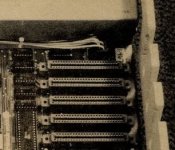Gary C
Veteran Member
But it doesn't play 8-track cartridges.
Nope, just compact cassettes
But it doesn't play 8-track cartridges.
Nope, just compact cassettes
 Based on my research there were about 250 ventless Apple II's made. The ventless on the cover of Micro The 6502 Journal OCT - NOV 1977 has a motherboard number of 467. If you consider the deviation between the motherboard and baseplate of the last ventless sold on ebay, which was 203, was 215, then you have to assume that there had to be at least 250 produced. The lowest number ventless that I have seen is 25, which has a deviation of 189 between the motherboard and baseplate. The latest one has a deviation of 215, which is number 203. Apparently, Apple continued to sell boards without cases during that time, which accounts for the difference. I purchased one of these board only revision 0's, after I was able to track down the original owner and verify the details.
Based on my research there were about 250 ventless Apple II's made. The ventless on the cover of Micro The 6502 Journal OCT - NOV 1977 has a motherboard number of 467. If you consider the deviation between the motherboard and baseplate of the last ventless sold on ebay, which was 203, was 215, then you have to assume that there had to be at least 250 produced. The lowest number ventless that I have seen is 25, which has a deviation of 189 between the motherboard and baseplate. The latest one has a deviation of 215, which is number 203. Apparently, Apple continued to sell boards without cases during that time, which accounts for the difference. I purchased one of these board only revision 0's, after I was able to track down the original owner and verify the details.Do collectors put any sort of premium on the Rev 0s that were sold loose, given that it seems some loose boards were sold in advance of the cases machines?
Side note: my Rev 0 appears to have disappeared into the bowels of my freight forwarder. 4 days since delivery and they haven't posted it for shipping out to me. Hopefully just being slow.. but a part of me always wonders if employees might be tempted 'lose' the odd valuable item.
My logic is that why collect a version of a product that is buggy? This is the equivalent of collecting factory-defective baseball cards, or dollar bills that were not cut correctly. The Rev 0 is technically a lousy and problematic version of the board, hence the multiple reversions of said board. I would think that the case and bottom alone is what is valued, and anything inside is irregardless because, as [falter] pointed out, at the time you actually used the equipment during the late 1970s/early 1980s, you just wanted a working computer, and everyone took advantage of the revisions of the guts of the computer.On the topic of bare boards, I'm not wrong in my belief that it's pretty much pointless to buy a Rev 0 case missing it's board, because .......
My logic is that why collect a version of a product that is buggy? This is the equivalent of collecting factory-defective baseball cards, or dollar bills that were not cut correctly. The Rev 0 is technically a lousy and problematic version of the board, hence the multiple reversions of said board. I would think that the case and bottom alone is what is valued, and anything inside is irregardless because, as [falter] pointed out, at the time you actually used the equipment during the late 1970s/early 1980s, you just wanted a working computer, and everyone took advantage of the revisions of the guts of the computer.
